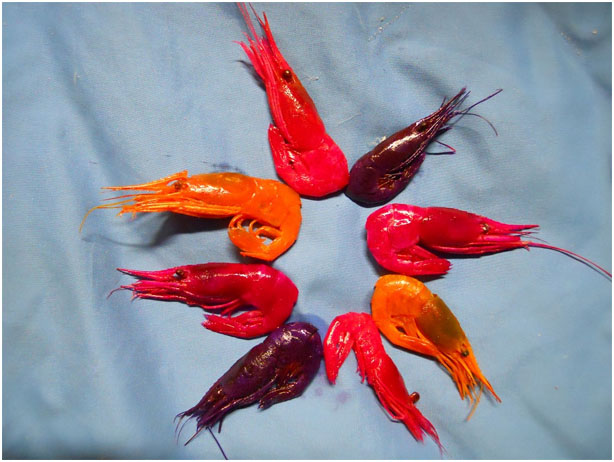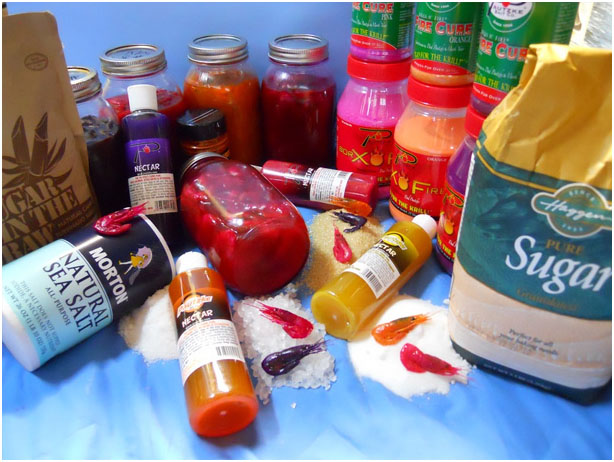How to Cure Shrimp 3
Fishing coon shrimp for salmon and steelhead isn't a new technique. Pacific Northwest Anglers have been employing the procedure for decades. Nonetheless, in the last few years the application has seen an influx in interest, likely a reflection of modern formulas that make brining the shrimp easier and more efficient than in the past.
There have been many recipes out there, but most of them that have been written about are on a massive scale literally requiring a guy to brine a five-gallon bucket of shrimp and your everyday angler doesn't need to brine that many shrimp. The recipe I use makes it easy for the average angler, whether one at guide's level or a newbie, to add shrimp to their arsenal. Now I don't want people to think that I've discovered something incredible here, because I haven't, but I've refined some older formulas that work for me and I know they are going to work for others.
An alternative to fishing eggs, sand shrimp or store bought tiger prawns, a well-brined coon shrimp gives anglers an edge by showing the fish something different and also appeals their senses. My formula is quick, easy to follow and creates durable, colorful and well-scented shrimp.
When fishing salmon or steelhead in the Pacific Northwest, you can run bait divers with eggs on them and you end up with a bait that's pecked apart by cutthroat, whitefish and smolts or, you can fish a tiger prawn with a Spin-N-Glo and catch steelhead. For some reason, we've found that a fish responds to a coon shrimp on a diver because it looks like a shrimp naturally drifting downriver. The nice thing about a coon shrimp is you don't hit as many small fish.

Coon shrimp have gained popularly throughout Washington, Oregon, Idaho and into British Columbia. The trend is likely here to stay.
It's become popular because it works. There's a lot of people that fish Ray's Baits, but there's also a lot of people that want to do it themselves because if everyone is using Ray's Baits there's a saturation of scent in these systems. You need to do things to your shrimp that will make them different from what everyone else is using. The brine I use can be used for any shrimp. Basically, we are trying to add color, scent and durability to the coon shrimp so that they fish well.

Unlike some shrimp species, a coon shrimp requires care and needs preparation prior to being fished. How well each angler performs these duties tends to reflect in their catch rates.
A coon shrimp is somewhat fragile, especially where the body and head are connected. Ideally, you'd like to find shrimp that are pre-cooked or flash boiled because it toughens the meat, ultimately producing a shrimp that's more durable. The process I use with Pautzke’s Nectar makes sure the bait is going to last the length of any drift when fishing them on a bait diver. The last thing you want to do is go through a drift, pull your lines and find out your bait is gone. The shrimp can have really good color and good scent, but if you put it in the water and it falls apart you are wasting your time. Color and scent don't mean anything if your bait falls apart just from dropping them down the river. Toughening them up is the key.
How To Brine Shrimp Properly

First and foremost, locating quality shrimp is imperative. Even when curing or brining them, if you start with poor quality shrimp you'll have bad results. Unfortunately, finding quality shrimp can be a chore. I recommend ordering from wholesale distributors or online. Another option is Asian fish markets, which normally sell various sizes of prawn with heads on. Most tackle shops don't sell uncured shrimp.
What To Buy: Look for head on shrimp 1.5-3 inches in length for steelhead and 3-4 inches for springers. As a parameter, in the recommended quart jar the recipe will cure roughly 60 shrimp.
Keep in mind, if you purchase one-pound of shrimp, you'll likely end up with a couple hundred shrimp. Consider 60 fitting in each quart jar, you could create five colors with Nectar and use about 300 shrimp. If you don't cure all the shrimp you purchased don't throw them away. Instead, freeze them in distilled water. I suggests not freezing them in tap water because of the chemicals/additives put in by water companies during the purification process. To freeze; place excess shrimp in a Tupperware container with a snap tight lid and pour in the distilled water, leaving enough room for expansion. Upon freezing they'll last several years.
Supplies for Brining Shrimp:
A Quart Jar
One Gallon of Distilled Water
Fine Granular White Sugar
Raw Sugar
Non-Iodized Sea Salt
Rock Salt
Pautzke Fire Power
Pautzke Nectar
Pautzke BoraX O Fire
Any Added Scents (Anise, Vanilla, Crawdad Juice, Sand Shrimp Oil)
Step 1
Mix the following contents into a one-quart glass mason jar:
1 full bottle of Pautzke Nectar (whichever color you choose)
1/4 cup BorX O Fire (match your color)
1/4 cup fine white granular sugar
1/4 cup of raw sugar
1/4 cup of non iodized sea salt
1/4 cup rock salt
1/2 to 1 teaspoon of Fire Power
Top off with distilled water
I suggest that anglers choose to use glass rather than plastic. Glass mason jars are far more effective, I believe, because with plastic you can potentially leech some of the plastic components into the brine, which can infuse a non-natural odor into the shrimp. We may not be able to detect that, but fish potentially can.
After placing the above-mentioned contents in the jar, I often add more scent.
There's already krill in the jar, yet I usually introduce one more scent into the brine.
You don't want to add three or four scents, but adding one more to the krill can be beneficial. For example, krill and anise, krill and crawdad, krill and vanilla can be good, but adding krill, crawdad and vanilla is too much. To sum it up, too much scent makes no sense.
Tip 1:
If you want to create a bolder bait, skip the distilled water and use two bottles of Pautzke’s Nectar. This is only for your red, orange or yellow. Purple and blue are dark enough.
Tip 2:
When placing contents in the jar, add the Fire Power after the water. It dissolves more fluently this way. When adding Fire Power last, it can be tough to mix. The Fire Power floats, clumps up and can be a chore to mix.
Step 2:
Sorting Shrimp
Not all shrimp are created equal. Picking out the finest shrimp from the batch will improve their effectiveness.
Any that are in fragile state, as in the head is soft or appears hollow, or if the head is separating from the body, it does no good to cure those shrimp. They won't fish well." "As you sort, look for firm, shrimp that are in tact.
Once you've sorted the shrimp in piles of 50 or 60, they are ready to be placed in the brine. Prior to adding the shrimp, use a long spoon and mix the contents well. Then, add up to 60 shrimp into the jar. Put the lid on. Seal it.
Step 3
Gently tumble jar, lightly shaking it to get all the contents off the bottom. Practice this for five minutes or less, simply to ensure proper mixing.
Tip 3: Once shrimp are placed in the brine, don't use a long spoon to try to mix contents further. Doing so has the potential to crush, damage and break them.
Step 4
Storage
For the first several weeks, store the jars on their side, rather than standing tall. Store it in a refrigerator on it's side, not at room temperature. These do better cold.
This is where you take ownership in it to ensure you are making a good product. A couple times a day, for the first two weeks, you have to pull your jar of shrimp out of your bait fridge, rotating it end to end and side to side to aid your brine in its' mixing process, ensuring that all the shrimp are being cured together.
There's reasons why I have different sizes of the granular product in the brine. The fine granular sugar and sea salt begin to break down early because of their size. They break down easier and are absorbed into the shrimp early on, initiating their curing process. The larger granular raw sugar and rock salt take more time to dissolve, or break down, thus sustaining the ability of the cure over time. As the salts and sugars break down and mix your brine it becomes thicker, almost like, but not as thick as a syrup. Seeing this is a good indicator that the brine is working.
Tip 4: One good indicator is after two to three weeks the shrimp will take on the color of the Nectar you used in your brine.
Step 5
Patience
This isn't a do-and-use process. A perfect shrimp isn't made overnight. Maturing can take several weeks. After two to three weeks they are ready to fish.
Fine shrimp takes time. This is like making wine. The longer it sits in the jar the better it works. The salts and sugars need time to break down and be absorbed by the meat of the shrimp.
Tip 5: When the shrimp have turned the color you choose based on the color of Nectar you used, they are ready to fish.
Tip 6: Alter for springers: The above specified brine is designed for steelhead. If you opt to cure shrimp for springers, remove 1/4 cup of sugar from the recipe and add 1/4 cup of salt. You can also add one teaspoon of sodium sulfite.

Whether you are in pursuit of Salmon or Steelhead, with just a few modifications to this recipe you can create one of the best bates around. Design it specific to the species of fish you are targeting and you will enjoy the results.
Good Fishing….
Duane Inglin
The Outdoor Line
710 ESPN Seattle
www.theoutdoorline.com


Great job Duane.. Keep it up!!!
Wow great info. How bout some herring cures for big C and the salt. Especially salt. I like the multi color idea!
Strong first blog Duane! I'm looking forward to some of your herring ideas for Columbia springers too! Welcome aboard!